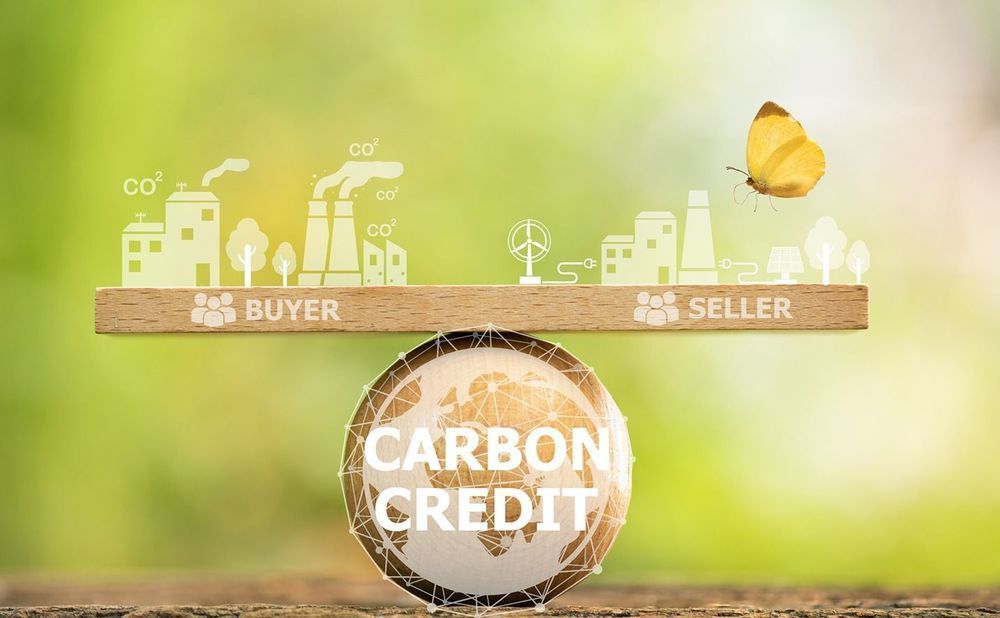Blog

As new initiatives are being implemented to mitigate the increasing amounts of GHG emissions on our planet, carbon credits open new horizons in the fight for carbon neutrality. In general terms, a carbon credit is a certified and tradable permit, giving the credit holder the right to emit one ton of carbon dioxide or the equivalent of another greenhouse gas. It is thus an offset for producers of such gases. The aim of carbon credits is to reduce the emissions of carbon dioxide (the most reactive and destructive GHG present) and other greenhouse gasses by recording and quantifying those emissions to transferable, tradable, and sellable units. Those units can therefore be generated through sustainable projects, eco-friendly and green initiatives (such as the implementation of solar fields), afforestation projects and social projects. These credits once generated can then be traded through carbon markets. Therefore, companies seeking to reduce their carbon and GHG emissions can purchase carbon credits (generated by the latter projects) thus offsetting (reducing) their carbon footprint upon purchase and retirement (removal from the carbon market) of those credits. Companies holding carbon credits may also sell their non-retired credits on the market at varied prices depending on market profiles. Some governments who seek to push the concept of Carbon allowances have now implemented carbon taxes on certain corporations and structures. In an area possessing a Compliance Carbon Market (CCM), a government or regulatory body imposes, to certain organisations, a limit on the total amount of greenhouse gas they can produce. Companies or organisations that emit less than their limit can sell the unused allowances (carbon credits) to others who are unable to reduce their emissions below the limit. These allowances can then be used to offset the emissions from another source. This system is also known as the cap and trade system and aims to provide an economic incentive for companies to reduce their carbon footprint and to help achieve overall emission reduction targets. Carbon credits can be generated from the following types of projects: Renewable energy projects (ex. wind, solar, hydropower) Energy efficiency projects (ex. building retrofits, industrial process improvements) Reforestation and forest preservation projects (only in some voluntary markets) Agricultural and livestock management projects (only in some voluntary markets) Destruction of potent greenhouse gases (e.g. HFCs, N2O) These projects can reduce greenhouse gas emissions and generate carbon credits that can be traded in carbon markets. The concept of carbon credits was developed to implement the emissions reductions required under the 1997 Kyoto Protocol; a treaty aimed at addressing the issue of global climate change. The Kyoto Protocol's carbon credit system helped to create a market for emissions reductions and provided an incentive for investment in low-carbon technologies and renewable energy. The most common type of carbon credits is the Certified Emission Reduction (CER) issued under the Clean Development Mechanism (CDM) of the Kyoto Protocol. In 2015, a global treaty was signed which has become known as the Paris Agreement, which aimed to limit global warming to below 2⁰ Celsius above pre-industrial levels and pursue efforts to limit the temperature increase to 1.5⁰ Celsius. Unlike the Kyoto Protocol, the Paris Agreement is a universal agreement and involves all countries, not just developed ones. The Paris Agreement does not have a specific mechanism for carbon credits, but encourages the use of market-based structures, such as emissions trading systems, to help countries achieve their emissions reduction targets. These systems allow for the creation of carbon credits that can be bought and sold to help countries offset their emissions. The carbon market is a rapidly growing industry, propelled by the need to reduce greenhouse gas emissions and address the issue of climate change. The carbon market operates on the principle of emissions trading, where companies and governments can buy and sell carbon credits to offset their emissions. The value of the carbon market is directly tied to the price of carbon credits, which varies depending on supply and demand. As governments and companies increase their efforts to reduce emissions, the demand for carbon credits is expected to grow, which could lead to further growth in the value of the carbon market. However, the carbon market also faces challenges, such as a lack of standardisation and regulatory certainty, that could impact its growth and development. Carbon markets have grown to reach a market value of USD 270 billion. Global macroeconomic forces have impacted carbon priced in the short run, but long term outlook for carbon markets and their contribution toward the net-zero transition remains constructive. The carbon market can play a significant role in the decarbonisation of the globe by putting a price on carbon emissions and giving polluter an option to reduce their emissions. Currently, carbon markets are categorised as either voluntary carbon markets (VCMs) or compliance carbon markets (CCMs), which are significantly different to each other in terms of regulations, impact and market size. VCMs are unregulated markets that allow individuals, firms, governments and industries to buy carbon offsets (carbon credits) from approved green projects generating carbon credits on a voluntary basis to achieve carbon compensation. The size of VCMs is currently with USD 1 billion of carbon offsets in 2021. The market has been estimated to reach a market value of UDS 4 billion in 2025. CCMs refer to as emissions trading systems or cap and trade programs. They are marketplace mechanisms where regulators auction off or distribute for free a limited number of carbon allowances (credits) to various regulated companies. Each carbon allowance typically allows its owners to emit one ton of a pollutant (such as C02). Firms that are more efficient in their emissions reductions can sell unused allowances to companies that need to purchase allowances for excess emissions. The idea behind carbon markets is that one the price of carbon had been internalised, the regulators allow the market to optimally decide the usage of other resources with a lever to reduce the overall supple of emissions allowances gradually. The estimated market values of CCMs exceeded USD 240 billion in 2021 and is most certainly expected to grow within the years to come. Although VCMs only represent a small portion of the overall market, they offer a more flexible approach to offsetting their carbon credits, all the while supporting green projects.

Climate change refers to long-term shifts in global or regional climate patterns, primarily resulting from the increase in greenhouse gas (GHG) concentrations in the Earth's atmosphere. It is primarily driven by human activities, such as the burning of fossil fuels, deforestation, and industrial processes, which release significant amounts of carbon dioxide (CO2) and other GHGs into the atmosphere. The Earth's climate has always experienced natural variations, but the current pace and scale of climate change is unprecedented. The burning of fossil fuels, particularly coal, oil, and natural gas, for energy production and transportation, has led to a substantial increase in CO2 emissions since the Industrial Revolution. These emissions, along with those from deforestation and other land-use changes, have resulted in an enhanced greenhouse effect, trapping more heat in the atmosphere and causing the planet to warm. The consequences of climate change are far-reaching and multifaceted. One of the most visible impacts is the rise in global average temperatures. This warming trend has led to numerous other changes, including melting glaciers and polar ice caps, rising sea levels, and increased frequency and intensity of extreme weather events such as heatwaves, hurricanes, and droughts. These events can have devastating effects on ecosystems, agriculture, water resources, and human populations, leading to loss of life, displacement, and economic disruptions. In addition to the physical impacts, climate change has social, economic, and geopolitical implications. Vulnerable communities, including those in low-lying coastal areas, arid regions, and small island nations, are particularly at risk. These communities often have limited resources and face challenges in adapting to climate change and recovering from its impacts. Climate change can exacerbate existing inequalities, increase social unrest, and contribute to forced migration and conflicts over resources. Recognizing the urgency and severity of the climate crisis, international efforts have been undertaken to address climate change and mitigate its impacts. The United Nations Framework Convention on Climate Change (UNFCCC) serves as the primary global platform for climate action. The landmark Paris Agreement, adopted in 2015, aims to limit global warming well below 2 degrees Celsius above pre-industrial levels and pursue efforts to limit the temperature increase to 1.5 degrees Celsius. The agreement calls for enhanced efforts to reduce GHG emissions, promote sustainable development, and provide financial and technological support to developing countries.

